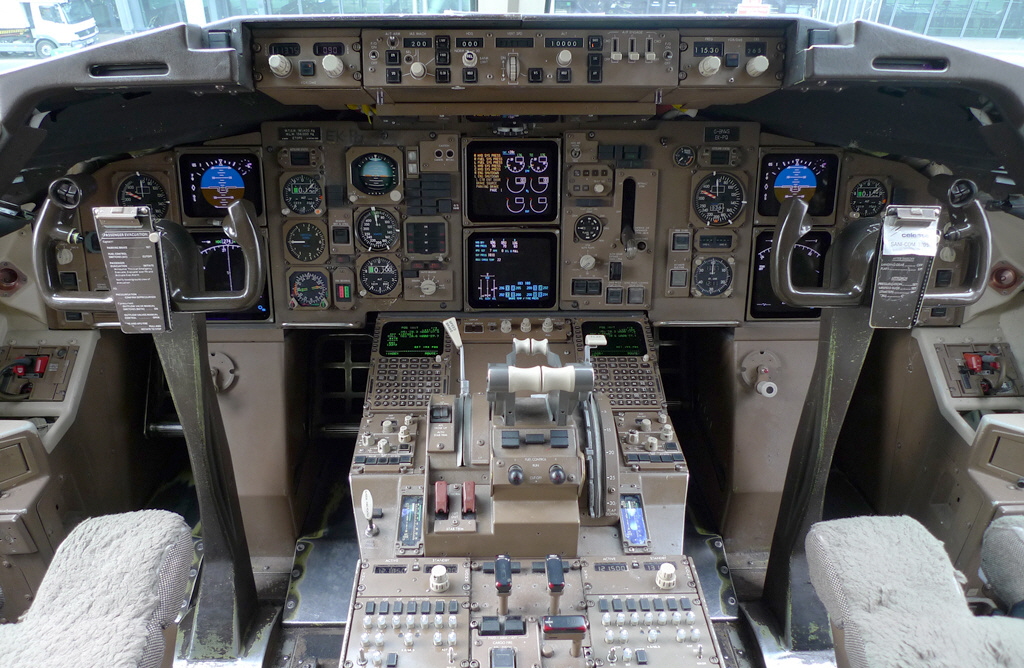 The Boeing 767 is a mid- to large-size, long-range, wide-body twin-engine jet airliner built by Boeing Commercial Airplanes. It was the manufacturer's first wide-body twinjet and its first airliner with a two crew glass cockpit with colour displays and new electronics replaced the role of the Flight Engineer by enabling the pilot and co-pilot to monitor aircraft systems directly. Despite the promise of reduced crew costs, United Airlines initially demanded a conventional three-person cockpit, citing concerns about the risks associated with introducing a new aircraft. A three-crew cockpit remained as an option and was fitted to the first production models. Ansett Australia ordered 767 aircraft with three-crew cockpits due to union demands; it was the only airline to operate 767 aircraft so configured. Development of the 767 occurred in tandem with a narrow-body twinjet, the 757, resulting in shared design features which allow pilots to obtain a common type rating to operate both aircraft.
The Boeing 767 is a mid- to large-size, long-range, wide-body twin-engine jet airliner built by Boeing Commercial Airplanes. It was the manufacturer's first wide-body twinjet and its first airliner with a two crew glass cockpit with colour displays and new electronics replaced the role of the Flight Engineer by enabling the pilot and co-pilot to monitor aircraft systems directly. Despite the promise of reduced crew costs, United Airlines initially demanded a conventional three-person cockpit, citing concerns about the risks associated with introducing a new aircraft. A three-crew cockpit remained as an option and was fitted to the first production models. Ansett Australia ordered 767 aircraft with three-crew cockpits due to union demands; it was the only airline to operate 767 aircraft so configured. Development of the 767 occurred in tandem with a narrow-body twinjet, the 757, resulting in shared design features which allow pilots to obtain a common type rating to operate both aircraft.
In February 1990, the first 767 equipped with Rolls-Royce RB211 turbofans, a 767-300, was delivered to British Airways. Six months later, the carrier temporarily grounded its entire 767 fleet after discovering cracks in the engine pylons of several aircraft. The cracks were related to the extra weight of the RB211 engines, which are 2,205 pounds (1,000kg) heavier than other 767 engines. During the grounding, interim repairs were conducted to alleviate stress on engine pylon components, and a parts redesign in 1991 prevented further cracks. Boeing also performed a structural reassessment, resulting in production changes and modifications to the engine pylons of all 767 aircraft in service
 United Airlines first placed the 767 in commercial service in 1982. The aircraft was initially flown on domestic and transcontinental routes, during which it demonstrated the reliability of its twinjet design. In 1985, the 767 became the first twin-engined airliner to receive regulatory approval for extended overseas flights. The aircraft was then used to expand non-stop service on medium- to long-haul intercontinental routes. In 1986, Boeing initiated studies for a higher capacity 767, ultimately leading to the development of the 777, a larger wide body twinjet. In the 1990s, the 767 became the most frequently used airliner for transatlantic flights between North America and Europe.
United Airlines first placed the 767 in commercial service in 1982. The aircraft was initially flown on domestic and transcontinental routes, during which it demonstrated the reliability of its twinjet design. In 1985, the 767 became the first twin-engined airliner to receive regulatory approval for extended overseas flights. The aircraft was then used to expand non-stop service on medium- to long-haul intercontinental routes. In 1986, Boeing initiated studies for a higher capacity 767, ultimately leading to the development of the 777, a larger wide body twinjet. In the 1990s, the 767 became the most frequently used airliner for transatlantic flights between North America and Europe.
The 767 is the first twinjet wide-body type to reach 1,000 aircraft delivered and the 777 ranks as one of Boeing's best selling models, with 1,061 aircraft built to February 2014. The most popular variant is the 767-300ER, with 582 delivered; Delta Air Lines is the largest operator, with 94 aircraft. British Airways has 21 767-300 aircraft in the fleet, mostly used on the trans-Atlantic routes as well as some European destinations. Because of rising fuel costs, airlines have acquired the type as a comparatively fuel-efficient alternative to other wide body jets and have increasingly deployed the aircraft on long-haul transoceanic routes.

